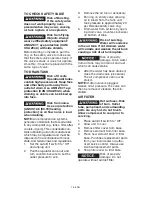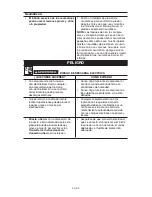
15 - ENG
TO CHECk SAFETY VALVE
Risk of Bursting.
If the safety valve
does not work properly, over-
pressurization may occur, causing
air tank rupture or an explosion.
Risk from Flying
Objects. Always
wear certified safety equipment:
ANSI Z87.1 eye protection (CAN/
CSA Z94.3) with side shields.
Before starting compressor, pull the
ring on the safety valve to make sure
that the safety valve operates freely. If
the valve is stuck or does not operate
smoothly, it must be replaced with the
same type of valve.
TO DRAIN TANk
Risk of Unsafe
OperationAir tanks
contain high pressure air. keep face
and other body parts away from
outlet of drain. Use ANSI Z87.1 eye
protection (CAN/ CSA Z94.3) when
draining as debris can be kicked up
into face.
Risk from noise.
Use ear protection
[ANSI S12.6 (S3.19) hearing
protection] as air flow noise is loud
when draining.
NOTE:
All compressed air systems
generate condensate that accumulates
in any drain point (e.g., tanks, filter, after-
coolers, dryers). This condensate con-
tains lubricating oil and/or substances
which may be regulated and must be
disposed of in accordance with local,
state, and federal laws and regulations.
1. Set the Auto/Off switch to "Off"
and unplug unit.
2. Pull the regulator knob out and
turn counterclockwise to set the
outlet pressure to zero.
3. Remove the air tool or accessory.
4. Pull ring on safety valve allowing
air to bleed from the tank until
tank pressure is approximately 20
psi. Release safety valve ring.
5. Drain water from air tank by open-
ing drain valve (counter-clockwise)
on bottom of tank.
Risk of bursting.
Water will condense
in the air tank. If not drained, water
will corrode and weaken the air tank
causing a risk of air tank rupture.
Risk of property
damage. Drain water
from air tank may contain oil and rust
which can cause stains.
6. After the water has been drained,
close the drain valve (clockwise).
The air compressor can now be
stored.
NOTE:
If drain valve is plugged,
release all air pressure. The valve can
then be removed, cleaned, the rein-
stalled.
AIR FILTER
Hot surfaces. Risk
of burn. Outlet
tube, pump head, and surrounding
parts are very hot, do not touch.
Allow compressor to cool prior to
servicing.
1. Place Auto/Off switch to "Off".
2. Allow unit to cool.
3. Remove filter cover from base.
4. Remove element from filter base.
5. Place new element back in filter
base. Purchase replacement parts
from your local dealer or autho-
rized service center. Always use
identical replacement parts.
6. Snap filter cover to filter base.
Risk of property
damage. Do not
operate without air inlet filter
















































